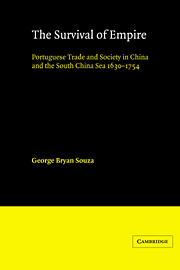Book contents
- Frontmatter
- Contents
- List of figures, maps and tables
- Glossary
- Notes on spelling and currency, weights and measures
- Preface
- 1 Maritime trade in Asia
- 2 Imperial foundations: the Estado da India and Macao
- 3 Population, personalities, and communal power
- 4 Country traders and Crown monopoly
- 5 Merchants and markets
- 6 Country traders and the search for markets
- 7 Imperial relations: Macao and the Estado da India
- 8 Imperial survival: Sino-Portuguese relations from Ming to Ch'ing
- 9 Macao, Companies and country traders: the other Europeans in China
- 10 Conclusion
- List of abbreviations and notes
- Primary Sources
- Bibliography
- Index
5 - Merchants and markets
Published online by Cambridge University Press: 24 October 2009
- Frontmatter
- Contents
- List of figures, maps and tables
- Glossary
- Notes on spelling and currency, weights and measures
- Preface
- 1 Maritime trade in Asia
- 2 Imperial foundations: the Estado da India and Macao
- 3 Population, personalities, and communal power
- 4 Country traders and Crown monopoly
- 5 Merchants and markets
- 6 Country traders and the search for markets
- 7 Imperial relations: Macao and the Estado da India
- 8 Imperial survival: Sino-Portuguese relations from Ming to Ch'ing
- 9 Macao, Companies and country traders: the other Europeans in China
- 10 Conclusion
- List of abbreviations and notes
- Primary Sources
- Bibliography
- Index
Summary
Macao's merchants had neglected the markets of the South China Sea. Their neglect, with the exception of Manila and, to a lesser degree, the Lesser Sunda islands, is explained by the magnitude of their trading opportunities in other markets. There were, in addition, costs and difficulties of penetrating new markets which they, previously, saw no economic reason to incur.
In the Indonesian archipelago, the Portuguese from Macao encountered competition from their compatriots at Malacca and from the Estado da India, the Spanish, the VOC, EIC, other European Companies, Chinese, Indian and indigenous merchants. Malacca and the Estado da India's trade in the South China Sea was east–west in orientation. It was directed towards the purchase of spices in the Indonesian archipelago, to be shipped to Goa and Cochin for transhipment to Europe, silver and Indian cotton cloth sent in exchange.
The development of Macao's trade to mainland Southeast Asia was influenced by the activities of Japanese and Chinese merchants. By the early seventeenth century, trade in various ports in the South China Sea increased in the north–south direction; Japanese go-shuin-sen and Chinese ships frequented the Tonkin, Cochinchina, Manila, Siam and Cambodia markets, which provided the Chinese products and locally produced silks, gold, aromatic woods and skins in demand in Japan. After discovering that the Chinese and Japanese had substantially improved the trade at those ports, Portuguese country traders from Macao sought to establish or augment existing local Portuguese populations and increase the frequency of their trading visits to those states. Catholic missionaries, especially the Jesuits, became active within those Portuguese and Japanese Christian communities.
- Type
- Chapter
- Information
- The Survival of EmpirePortuguese Trade and Society in China and the South China Sea 1630–1754, pp. 87 - 123Publisher: Cambridge University PressPrint publication year: 1986

